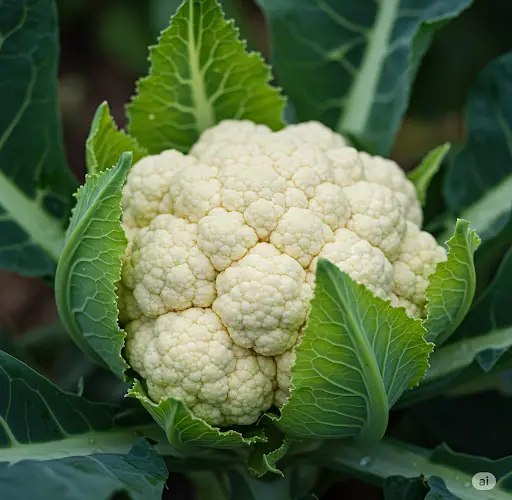Cauliflower is a nutritious, versatile vegetable that can be a rewarding addition to any garden. Known for its dense, white curds and mild flavor, cauliflower is a cool-season crop that requires a bit of care and attention but offers a delicious harvest in return. Whether you’re a home gardener or new to vegetable farming, this comprehensive guide will help you successfully grow and harvest cauliflower.
Why Grow Cauliflower?
Cauliflower is rich in vitamins C and K, fiber, and antioxidants. It’s low in calories and can be used in countless recipes—from roasting and steaming to rice substitutes and creamy soups. Growing your own cauliflower allows you to enjoy fresh, chemical-free produce that can be harvested at peak flavor.
Though it has a reputation for being somewhat challenging to grow, with the right conditions and care, cauliflower thrives and produces impressive heads.
Choosing the Right Cauliflower Variety
There are several varieties of cauliflower, each suited to different climates and growing seasons. Selecting the right type for your area and your growing timeline is crucial.
-
Early varieties: Mature in about 55–70 days and are ideal for spring or early fall planting.
-
Mid-season varieties: Take 70–90 days to mature and are suited for summer or fall harvests.
-
Late varieties: Require 90+ days and are best for fall or winter growing in mild climates.
In addition to the classic white cauliflower, there are also colorful varieties like purple, orange, and green, which can add visual interest to your garden and meals.
Preparing the Soil
Cauliflower prefers rich, well-drained soil with a pH between 6.0 and 7.0. It is a heavy feeder, so soil fertility is key.
Soil preparation tips:
-
Work in plenty of organic matter, such as compost or well-rotted manure, before planting.
-
Ensure the soil is loose and well-drained to encourage healthy root growth.
-
Consider a balanced fertilizer or side-dressing with nitrogen during the growing season.
Starting Seeds and Transplanting
Cauliflower seedlings are usually started indoors 4–6 weeks before the last expected frost date. This gives them a head start on the growing season.
Steps for starting seedlings:
-
Sow seeds about ¼ inch deep in seed trays or small pots.
-
Keep the soil moist and maintain a temperature around 18–21°C (65–70°F).
-
Transplant seedlings outdoors when they have 4–6 true leaves and after hardening them off for about a week.
If you prefer, you can also purchase young seedlings from a nursery to plant directly.
Planting Cauliflower Outdoors
When transplanting cauliflower, space plants 18–24 inches apart with 24–30 inches between rows. This spacing allows enough room for the heads to form and air to circulate, reducing disease risks.
Plant cauliflower in full sun for best growth, though it tolerates some light shade.
Caring for Cauliflower Plants
Consistent care is essential for healthy cauliflower growth:
-
Watering: Cauliflower requires even moisture to develop dense heads. Water regularly to keep the soil consistently moist but not waterlogged.
-
Fertilizing: Feed plants with a nitrogen-rich fertilizer during early growth, switching to a balanced formula as heads begin to form.
-
Mulching: Apply mulch around the base to retain moisture, suppress weeds, and regulate soil temperature.
-
Weeding: Keep the area weed-free to reduce competition for nutrients and water.
Blanching Cauliflower Heads
To maintain cauliflower’s bright white color and prevent bitterness, many gardeners practice blanching. This involves covering the heads to protect them from sunlight.
How to blanch cauliflower:
-
When the head reaches about 2–3 inches in diameter, gather the large outer leaves over the developing curd and tie them loosely with a soft string or use a cloth to cover.
-
This shields the head from sun exposure, helping it stay white and tender.
-
Some modern varieties are self-blanching and don’t require this step.
Pests and Disease Management
Cauliflower can fall victim to several pests and diseases if not monitored closely:
Common pests:
-
Cabbage worms and loopers
-
Aphids
-
Flea beetles
-
Slugs and snails
Common diseases:
-
Black rot
-
Clubroot
-
Downy mildew
Prevention and control tips:
-
Rotate crops to avoid disease buildup in soil.
-
Inspect plants regularly and handpick pests.
-
Use row covers early in the season to protect seedlings.
-
Apply organic insecticides or neem oil if infestations become severe.
Harvesting Cauliflower
Cauliflower is ready to harvest when the heads are firm, compact, and reach about 6–8 inches in diameter (depending on variety). The heads should be white or the color typical of your variety, and the curds tightly packed.
Harvest tips:
-
Use a sharp knife to cut the head off at the base, leaving a few outer leaves around it for protection.
-
Harvest promptly once the head matures to avoid it becoming loose or turning yellow.
-
Cauliflower can be stored in the refrigerator for up to two weeks.
Final Thoughts
Growing cauliflower can seem challenging, but with the right preparation and care, it’s a highly rewarding crop. From selecting the right variety to mastering watering, fertilizing, and pest control, this vegetable will provide you with fresh, homegrown produce that’s well worth the effort.
Whether you’re planting a small home garden or growing cauliflower commercially, following these best practices will help you achieve a healthy, abundant harvest.



